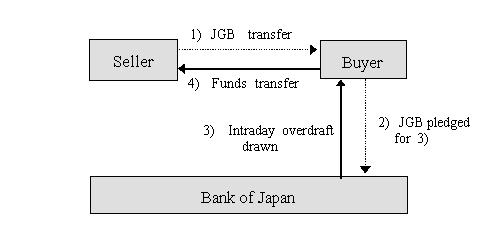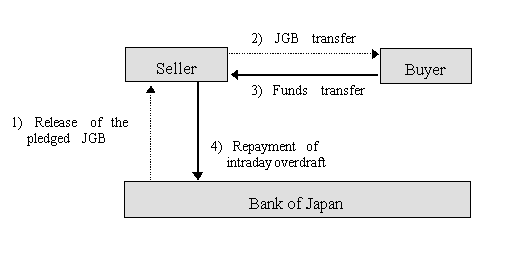The Framework for Restructuring BOJ-NET JGB Services1
September 4, 1998
Bank of Japan
1. RTGS to be the principal settlement mode over BOJ-NET JGB Services Introduction2
The Bank of Japan has decided to settle all Japanese government bonds and bills (JGBs) on a real-time gross settlement (RTGS) basis, except for some transactions over JGB Services of the Bank of Japan Financial Network System (BOJ-NET), by the end of the year 2000.Settlement over BOJ-NET JGB Services will be made by RTGS with the following three exceptions,3which will continue to be settled by designated-time settlement (at 3:00 p.m.): (1) transactions of JGBs kept in custody with the Bank by foreign central banks and international institutions, (2) JGB issues whose proceeds are paid in by online instructions, and (3) transactions associated with market operations of long-term JGBs whose buyer is the Bank.
2. Services and operations to be introduced to support RTGS
Special collateralization facility
In order to enable smooth settlement of a large volume of DVP transactions over BOJ-NET JGB Services on the RTGS basis, a new liquidity-saving facility will be provided whereby a participant will post (take back) the securities traded in DVP transactions as collateral at the Bank to obtain (repay) intraday funds needed for the payment for the transactions concerned.4 This simultaneous and linked processing of DVP (between a buying participant and a selling participant) and a collateral transaction (between a participant and the Bank), which is hereafter referred to as SPDC (for simultaneous processing of DVP and collateralization), works as follows.
- (1) A buying participant in BOJ-NET JGB Services is able, by using SPDC, to do the following four things for each of its JGB settlements at the same time: 1) receive the JGB from a seller, 2) pledge this JGB to the Bank as collateral for an intraday overdraft, 3) draw the intraday overdraft from the Bank, and 4) pay the seller funds for the JGB.
- (2) A selling participant in BOJ-NET JGB Services is able, by using SPDC, to do the following four things for each of its JGB settlements at the same time: 1) take back the pledged JGB from the Bank, 2) deliver this JGB to a buyer, 3) receive from the buyer funds for the JGB sold, and 4) repay the intraday overdraft to the Bank.
- (3) These two processes occur at the same time when both the buyer and the seller of the JGB use the facility.
Funds transfers using SPDC can be settled across special current accounts held by participants at the Bank besides basic current accounts used for funds transfers.5 The use of special current accounts will be limited to the operating hours of BOJ-NET JGB Services from 9:00 a.m. to 4:00 p.m. (see below).6
CPU-to-CPU link and the extension of operating hours
To ensure rapid processing of a number of JGB transactions to be settled within a day under the RTGS environment, a CPU-to-CPU link system, connecting participants' host computers with the BOJ-NET, will be developed.Data to be transmitted via CPU-to-CPU link will include major types of messages for transactions that cause changes in balances of participants' securities accounts, such as transfer instructions in registration and book-entry systems, and instructions for the DVP processing.
In addition, the operating hours of BOJ-NET JGB Services on the RTGS basis will be extended by one hour, with the cut-off time for online input changing from the current 3:00 p.m. to 4:00 p.m.7 This meets the needs of participants wishing to settle non-RTGS securities they receive in the designated-time settlement at 3:00 p.m.
Other new facilities
Several other facilities will be introduced in addition to SPDC.They will include the following:
- (1) a facility enabling a buyer of securities to request reconfirmation of the data input by a seller which the buyer believes to contain inaccurate information;
- (2) a facility notifying both seller and buyer of the time taken from input of the securities transfer instruction by the seller to input of the funds transfer instruction by the buyer; and
- (3) a facility notifying a seller of securities that the balance of its securities account is insufficient to complete settlement.
The Bank will be working on operational details of the planned RTGS for both the BOJ-NET funds transfer system and JGB Services, and will provide private financial institutions with further information on progress in due course.
- This is a summary excerpted and translated from an original paper in Japanese, which is available from the Financial and Payment System Office of the Bank (tel: +81-3-3279-1111; fax: +81-3-5255-6752).For the preceding discussion on enhancing features of RTGS over the BOJ-NET, see "The Framework for Restructuring the BOJ-NET Funds Transfer System," Bank of Japan Quarterly Bulletin, August 1997.
- BOJ-NET JGB Services, operated by the Bank, provides online settlement of JGB-related transactions.In the existing system, settlements are executed according to two types of processing: (1) "priority processing," or RTGS, whereby transfer orders are individually processed and settled immediately on receipt; and (2) "normal processing," or designated-time settlement, whereby transfer orders are collectively processed with other transfer orders specified as "normal processing" after the input deadline at 3:00 p.m.For details, see "Response to the Disclosure Framework for Securities Settlement Systems: The BOJ-NET JGB Services," Bank of Japan Quarterly Bulletin, February 1998.
- For all these three types of transaction, RTGS is to be introduced soon after the restructuring of the BOJ-NET funds transfer system and JGB Services as mentioned above.
- The use of the facility will be limited to those of the system's online participants who hold current accounts at the Bank.Also, participants will not be allowed to use other securities than their own for this facility.
- A financial institution using SPDC will be able to open a special current account for each branch or office.Transfer of funds between the basic current account and the special current account for SPDC will be possible, so will transfer of the securities collateral for intraday liquidity and that for SPDC.
- Accordingly, participants will be required to return the balance of their special current accounts to zero prior to the cut-off time at 4:00 p.m.
- The cut-off time for paper-based instruction will also be extended to 4:00 p.m.


